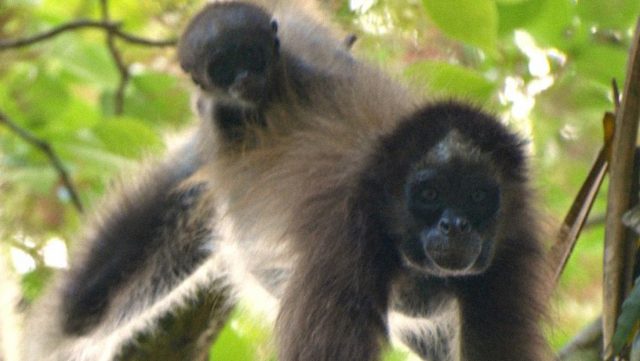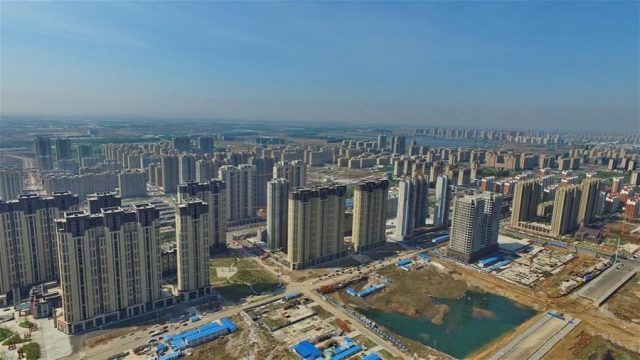The last stronghold of the primary forests that covered the plains of Venezuela and Colombia in ancient times, and which is also the home of the spider monkey -primate in critical danger of extinction-, is completely threatened by deforestation and illegal invasions, actions which have caused that of the 184,000 hectares that were declared as a Forest Reserve 60 years ago, now only 7,000 remain.
This important area of biodiversity is located in Caparo, in the state of Barinas, southwestern Venezuela, an Area Under Special Administration Regime (ABRAE) that despite having been declared a reserve, was ceded more than half a century ago in concession to private companies for ‘sustainable logging’.
Deforestation in Caparo has brought the reserve to a critical point, where the only surviving forest remnant is the one that has been under the special administration of the Universidad de los Andes (ULA) since 1982 through the Caparo Experimental Station (EEC), created for scientific research and that in recent years has become a trench of struggle.
In the EEC, the Spider Monkey Project has operated since 2013, led by biologist Diana Liz Duque Sandoval, who has been in the conflict zone since 2010, when she began a doctoral thesis study on Caparo and its biodiversity.
Duque spoke with RT so as to make known the work that she develops as an environmental activist and the impact that the project has to preserve the forest, the spider monkey and the biodiversity of that region, which is in danger of disappearing if appropriate measures are not taken.
What is the situation of the spider monkey and the Caparo forest?
Among the recurring problems that are generated in Caparo, is the fight against a continuous occupation process that consists of the expansion of farms and pastures already established, uncontrolled deforestation, arson attacks, defragmentation of the habitat, loss of biological diversity and excessive exploitation of natural resources.
Duque explains that the few intact hectares of Caparo are maintained by the work carried out by the EEC staff. Otherwise – she claims – the forest would no longer exist due to the recurring invasions and arson attacks that devastate everything in its path.
“Caparo represents the last forested remnant of the region of the western plains of Venezuela, and it is the only refuge for the biodiversity of what previously existed in more than 3 million hectares of primary forests. Now they are threatened by invaders, hunters and arson attacks ”, explains the environmental activist.
The biologist adds that despite the fact that these 7,000 hectares are protected and that the Government has taken specific actions against the invasions, the danger persists because the invaders do not cease in their attempts to take over the lands, saying that they are idle and that they need them for agricultural activities.
The civilian population that lives in the vicinity of Caparo is also worrying, says Duque, as many young people have dropped out of school due to the absence of teachers and the difficulties in obtaining fuel, a situation that they try to help solve, especially for children. .
The importance of the spider monkey project and its fight has been recognized by the Faculty of Forestry and Environmental Sciences of the ULA, when decreeing the primate as the emblem of the EEC, a place where scientists, students and university teachers carry out research, extension and conservation work .
Struggles and difficulties
Since the Spider Monkey Project has been working in Caparo, the last few years have been the most difficult. In January 2018, some 200 people invaded the station and during the occupation, which lasted almost the whole year, they destroyed 100 hectares of forest and hunted hundreds of wild animals.
«It was not until the last month of 2018 that the national government achieved the eviction, but those responsible were not punished», said Duque, who commented that a group of National Guards and Army soldiers remained in the area after the invasion, to assist the forest rangers’ surveillance tasks.
In 2019, they had to face a massive forest fire that was caused intentionally and in 2020 they fought against seven more attempts of illegal occupations, where the personnel working at the station again received threats against their life.
When this happens – explains Duque – the people who are inside the reservation are exposed, because as they find themselves far from the city, access to gasoline and vehicles that quickly mobilize them to ask for help from the authorities is difficult.
“Unfortunately, given this, we need to move quickly but we do not have gasoline in the area, we do not have a vehicle, only motorcycles that sometimes run out of gasoline because we cannot find it. That is why it is necessary for the authorities to respond more effectively and quickly to these emergencies”, she explains.
The biologist urges the State, private companies and organizations that may be interested, to provide support to Caparo, given that the ULA does not have the resources to support the maintenance of the experimental station, and this has led to the deterioration of the camp site.
How was the project born?
«The Spider Monkey Project is an initiative that was born in 2013 for the conservation of the critically endangered spider monkey (ateles hybridus) and the Caparo forest, also in constant danger due to invasions», explains Duque.
Other primates also inhabit Caparo, such as the white-faced capuchin monkey (Cebus albifrons) and the howler monkey (Alouatta arctoidea). In addition, the forest protects the life of other threatened species such as the jaguar, the puma, the tapir, the water dog or giant otter, the giant armadillo, the paujil, among others.
In the case of the spider monkey – Duque explains – there are two species that inhabit Venezuela, the one from the north – known as «long-sleeved» in the plains region – which lives in Caparo in a critical condition of extinction, threatened mainly by the loss of habitat; and the southern one (ateles belzebuth), which lives in other regions but is also in danger.
Caparo is not the only region where the spider monkey inhabits. The primate can also be found in the Venezuelan states of Táchira, Apure, Trujillo, the Sierra de Perijá in Zulia, the Cordillera de la Costa and the Guatopo National Park, between Miranda and Guárico. In addition, its presence in the San Esteban and Henri Pittier national parks, between the states of Aragua and Carabobo, is yet to be confirmed; and the Waraira Repano, which includes the Capital District, and the states of La Guaira and Miranda.
The project directed by Duque has sought to generate new habitat areas for the spider monkey and distribute them in places where they are not exposed, but these actions are paralyzed due to logistical difficulties that have not allowed this work to continue.
This particular species, known as an important seed disperser, is brown in color, with long arms and a flexible tail. It has an exclusively arboreal lifestyle and also inhabits specific areas of Colombia, located in the departments of Magdalena, Cesar, Caldas, Cundinamarca and La Guajira.
Spider monkey: an ‘umbrella species’
The spider monkey has been identified as an ‘umbrella species’, since its conservation also protects large areas of forest, as is the case with the South American frontin bear, which has a positive impact on the preservation of other endangered species.
For this reason, among the proposals that have arisen to preserve the spider monkey and its habitat, is that the Caparo reserve be included by UNESCO in its list of places recognized as World Natural Heritage.
There is also an initiative designed by several scientists that aims for the parliament to enact an Organic Law, which stipulates the action of the State and society on the management and protection of Caparo, since they consider that this region should be certified as a genetic safeguard for posterity that would allow the development of restoration projects in areas that are degraded.
In addition – Duque highlights – the work around the care of the spider monkey has allowed university students to carry out research projects in Caparo, including undergraduate thesis, environmental education projects and conservation actions.
“We have the Caparo Ranger Project, which is the most important, because with that project, we have kept the forest safe in recent years. We also carried out the first Forest Restoration Project to create an ecological corridor, activities that have been made possible thanks to the support of the zoos of France and New Zealand ”.
The biologist also considers it necessary to increase educational campaigns, that there is greater political will to protect the forest and that the military personnel who help the reserve can have vehicles and easy access to gasoline to carry out continuous patrol work, allowing them to detect any irregularities.











